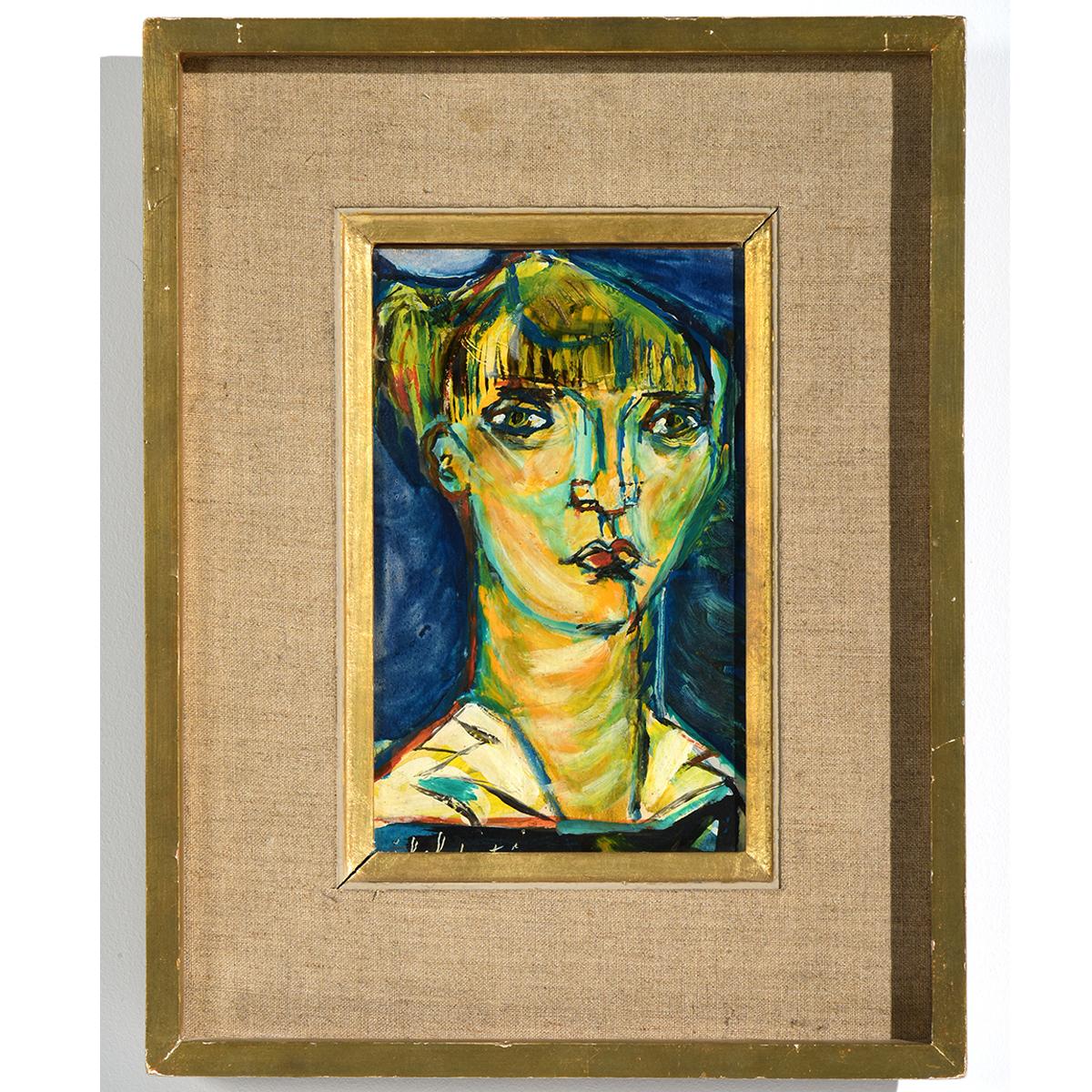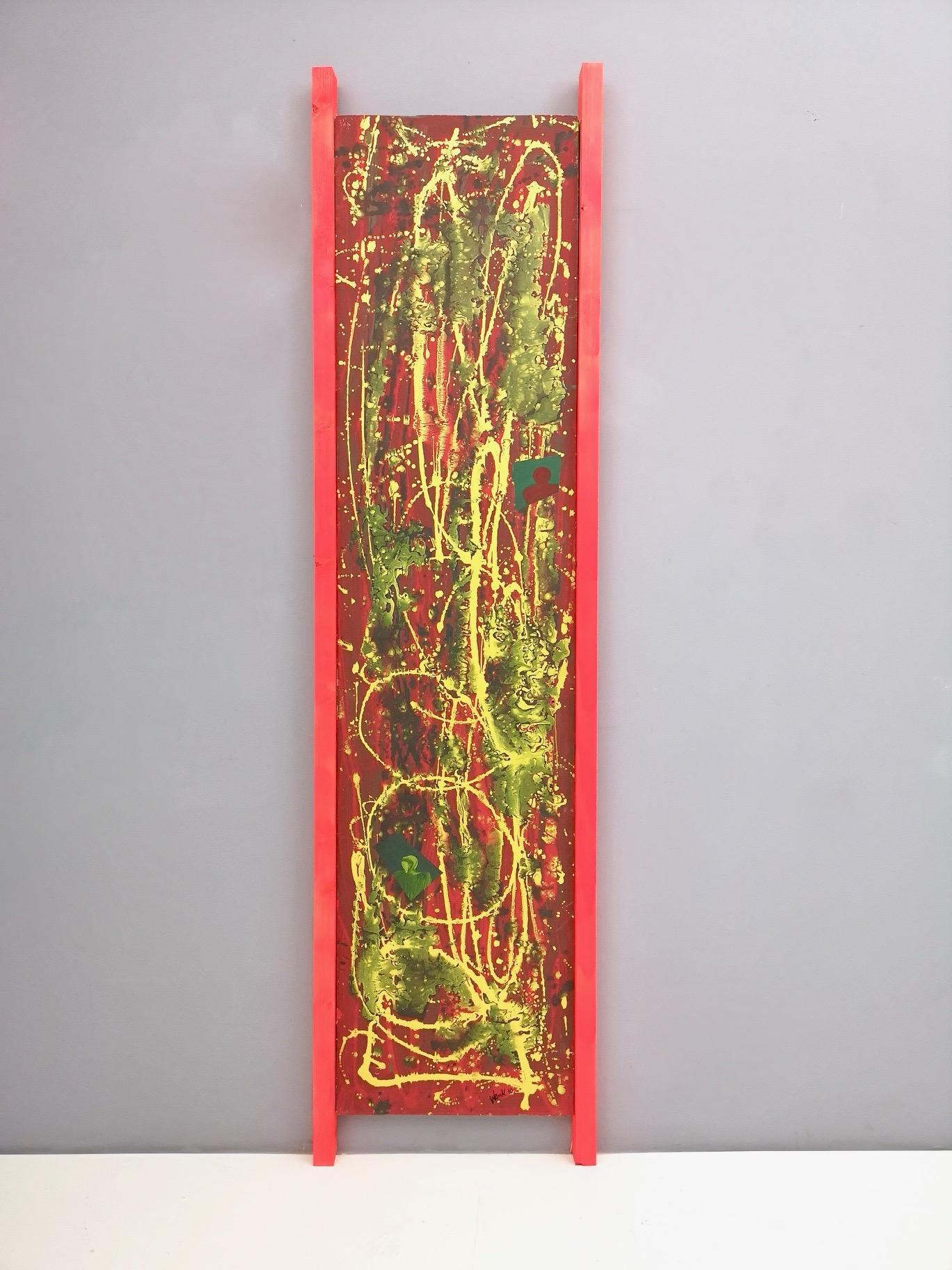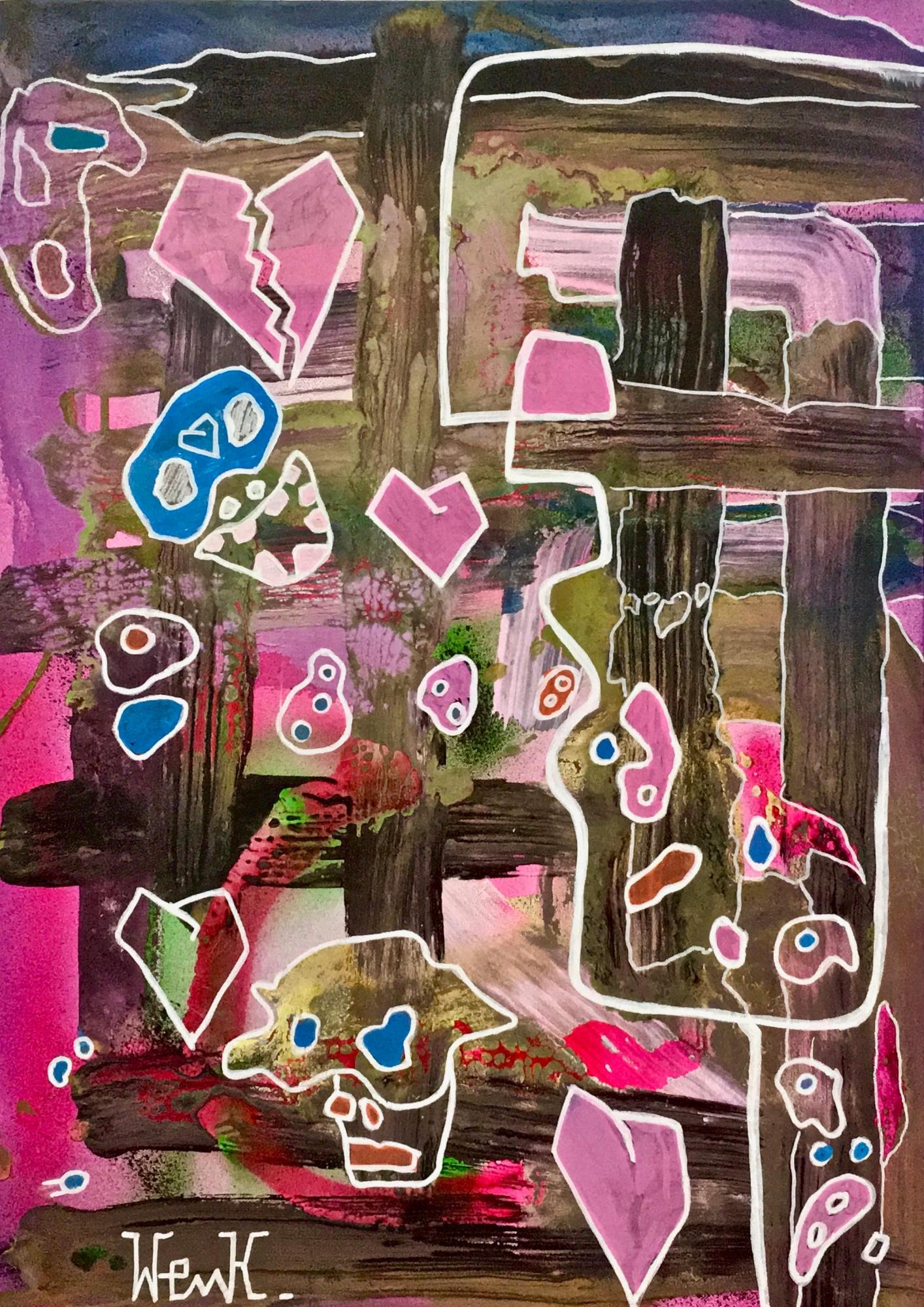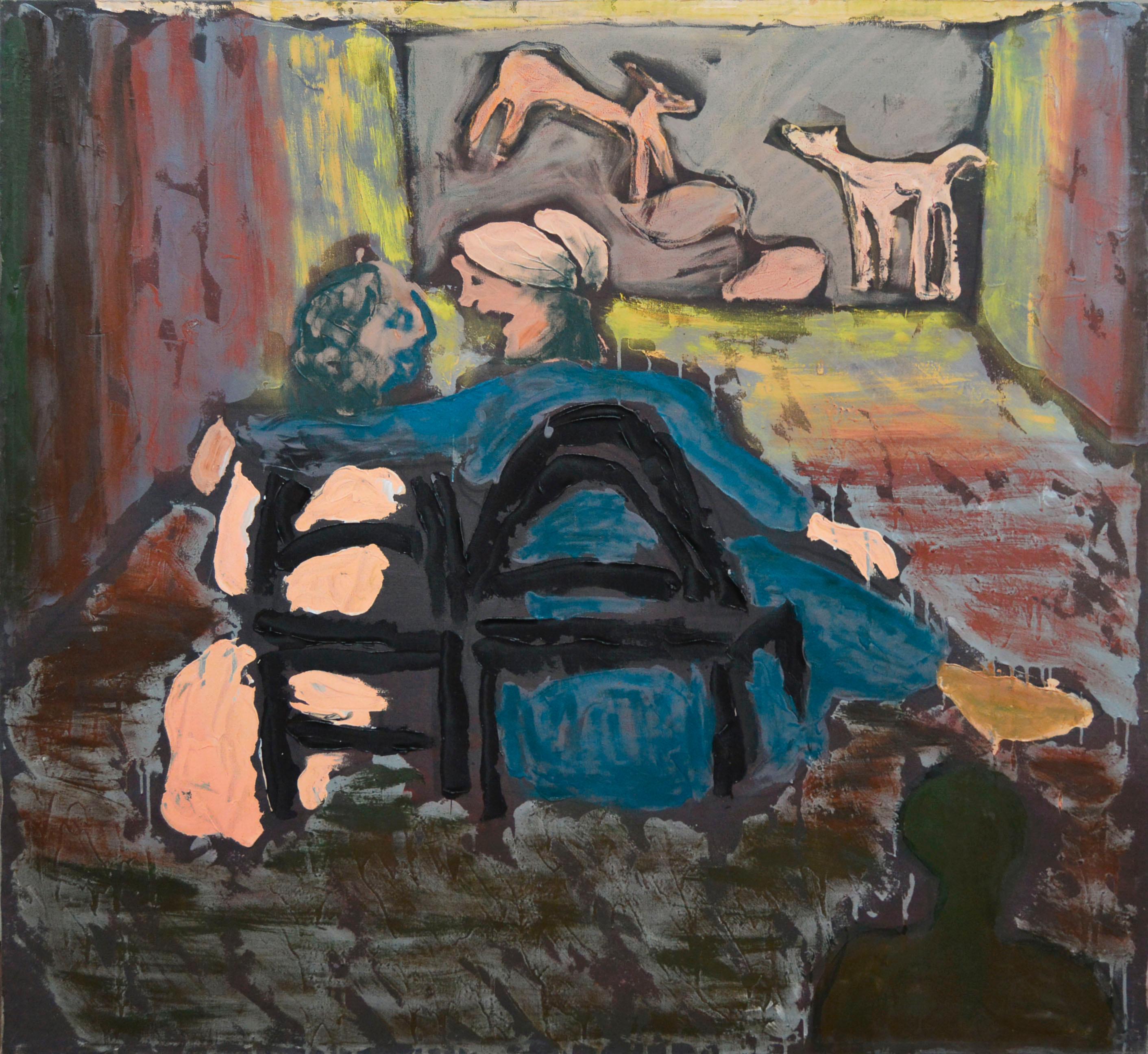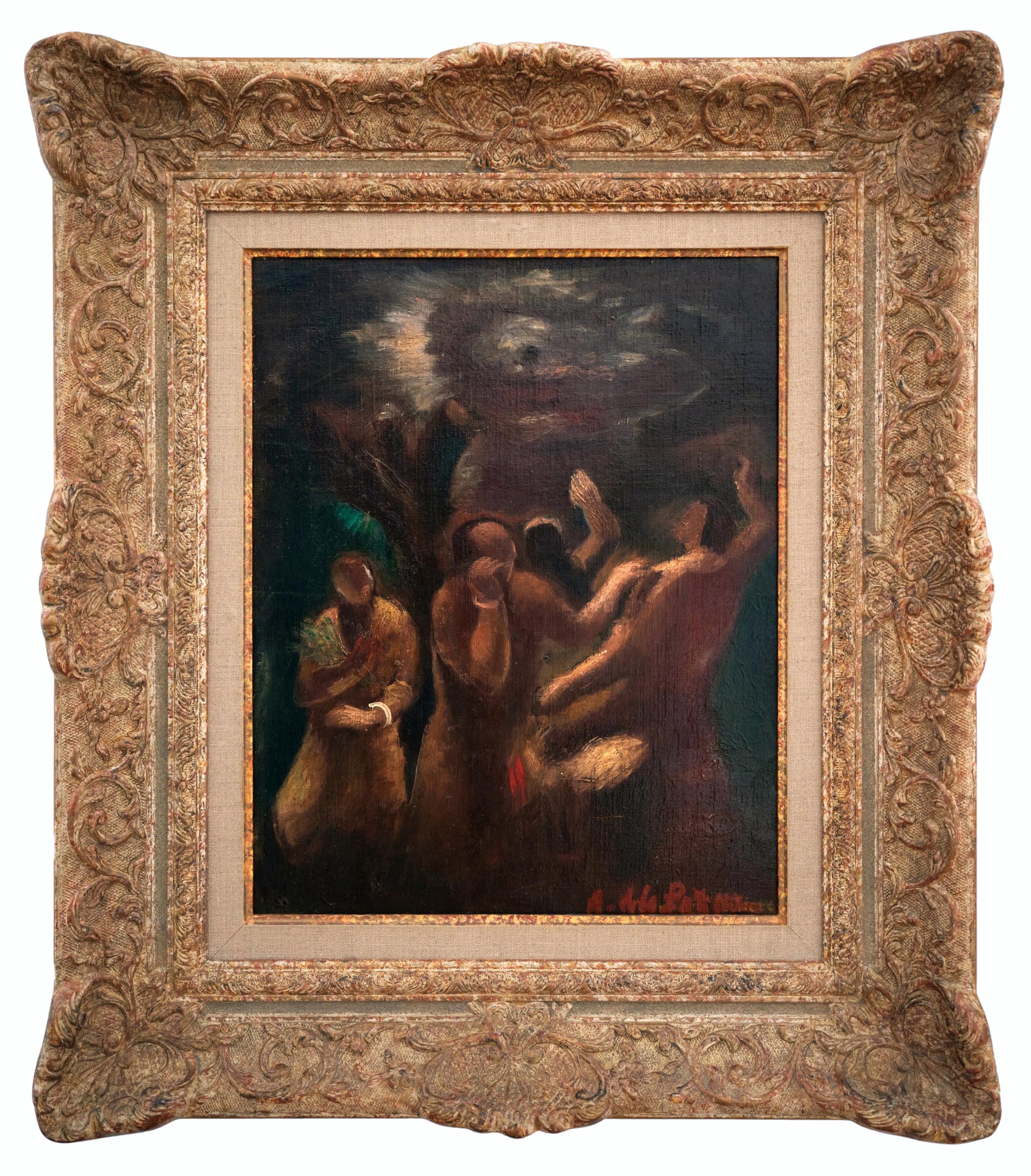Items Similar to Post Soviet Avant Garde Judaica Rabbi Playing Violin (the Klezmer Fiddler)
Want more images or videos?
Request additional images or videos from the seller
1 of 7
Yuri BrusovanyPost Soviet Avant Garde Judaica Rabbi Playing Violin (the Klezmer Fiddler)1995
1995
About the Item
Genre: Contemporary
Subject: People
Medium: Oil
Surface: Canvas
Dimensions: 24" x 18"
Yuri Yefimovitch Brusovany was born on November, 15th 1949 in Leningrad (St. Petersburg) Russia. His father was a Jew from Gomel. His mother descended from the prominent family of Samoiloff Actors. This family was well-known all over Russia for a long time. Since 1820 names of the actors from the Samoiloffs' Dynasty never left the theatre posters. It was the largest family tree in the history of Russian scenic art. The central figure in the dynasty was V.V. Samoiloff (1834 - 1877) lived at the same time with Feodor Dostoevsky, Karl Brullov and Leo Tolstoy. V.V. Samoiloff, P.V. Samoiloff and V.A. Michurina-Samoilova were buried at the Alexander Nevsky Monastery in St. Petersburg at the place where the greatest people of Russian Culture lay.
Yuri started painting in his early childhood. In 1962 - 1968 he studied at the Art School for gifted children at the Repin's Academy of Fine Art. In 1970 he became a student of Mukhina's (now, again, - Shtiglits) Academy of Decorative and Apply Art, specializing in monumental art. In 1975 he graduated from the Academy.
Yuri Brusovany had not been granted with official recognition until Perestroika. He was refused the membership in the Artists Union (altogether with the professional rights and privileges). In 1976 he joined the informal society of free artists in Leningrad (TEII). He chose the path of the decedents. Being a fierce antagonist to social realism, which was an official art theme in Soviet Union, he was pursued by the authorities, officially condemned and experienced a pressure from KGB's internal affairs. He was also in conflict with the soviet officials for his Bible, Hebrew and Jewish culture studies.
He took part in the exhibitions of the decedent artists in 1982, 1984, 1986, 1988. Fortunately, the political pressure gradually dissolved with Perestroika and Yuri can now enjoy a better environment.
1985 - His first personal exhibition took place at the Palace of Youth in Leningrad (St. Petersburg), Russia
1988 - He participated at the Exhibition of Free Russian Modern Arts Fund in Germany
1989 - Exhibition in Hettingen, Germany
1989 - Exhibition in Stockholm, Sweden
1990 - His Album ''Voices and Shadows'' was published by the Soviet Arts Fund
1991, 1999 - Personal exhibitions took place at the Smolny Cathedral in St. Petersburg, Russia
1999, 2000 - Personal exhibitions at Russian State Museum of Ethnography, St. Petersburg, Russia
2000 - Personal exhibition at the Russian House, Berlin, Germany
2000 - Personal exhibition at the Gallery ''Elite'', Dresden, Germany
Yuri's artworks are in private collections in France, Japan, Germany, Israel, Sweden, England, Russia, USA.
- Creator:Yuri Brusovany (1949, Russian)
- Creation Year:1995
- Dimensions:Height: 24 in (60.96 cm)Width: 18 in (45.72 cm)
- Medium:
- Movement & Style:
- Period:
- Condition:
- Gallery Location:Surfside, FL
- Reference Number:1stDibs: LU38211854652
About the Seller
4.9
Platinum Seller
These expertly vetted sellers are 1stDibs' most experienced sellers and are rated highest by our customers.
Established in 1995
1stDibs seller since 2014
1,565 sales on 1stDibs
Typical response time: 1 hour
- ShippingRetrieving quote...Ships From: Surfside, FL
- Return PolicyA return for this item may be initiated within 3 days of delivery.
More From This SellerView All
- Polish French Jewish Artist Oil Painting Girl with Doll, School of Paris JudaicaBy Walter SpitzerLocated in Surfside, FLFramed 27 X 24 inches Sight 18 X 15 inches Walter Spitzer (Polish/French, 1927 - ) born in Cieszyn, Poland. A Polish Jewish Holocaust survivor, he made his first drawings in a concentration camp. Walter Spitzer has lived and worked since WWII in France, where he studied at the École des Beaux Arts in Paris. Walter Spitzer has achieved great renown as a painter and printmaker. Whether in his paintings of Biblical subjects or in lithographs of Shtetl scenes, His humanity was inspired by the writings of Sartre, Montherlant and Kazantzakis, Walter Spitzer is occupied with two great, interlinked themes: man’s inhumanity to man, and the humanity of man. He will surely be recognized in the future as one of the great witnesses to the twentieth-century experience. Walter Spitzer was born in Chieszyn, Poland, the son of a Jewish liqueur producer, and attended the German school there. He began to draw and paint at an early age. In 1939 the Spitzer family was forcibly removed by the Germans to the town of Strzemieszyce, which was turned into a ghetto in 1942. When the ghetto was liquidated in June 1943 Spitzer’s mother was shot, and the sixteen-year-old Walter was deported to Blechhammer, a subcamp of Auschwitz. There he painted portraits of Wehrmacht soldiers and fellow inmates in exchange for food. He was one of the few to survive the evacuation march from Auschwitz to Buchenwald, where to begin with, in late February 1945, he was held in the Little Camp. To enable him to make drawings documenting life in the camp, the Communists organized his transfer to the main camp. While on a death march in early April he made his escape in the vicinity of Jena and was soon in the hands of the Americans. Spitzer served as an interpreter with an American army unit, and at the same time executed numerous drawings depicting the world of the camps. In June 1945 the Americans took him to Paris, where – following the advice of his father, who had died in 1940 – he began to study art at the École des Beaux-Arts in Par the following year. After completing his training as an artist he produced paintings expressing a critical view of the society of his day. In 1955, in commemoration of the camps and the death marches, he executed a cycle of nine etchings in an edition of thirty, which he gave to various museums in Israel and in France. In the 1960s he established himself as an illustrator of exclusive editions of works by such authors as André Malraux, Jean-Paul Sartre, Joseph Kessel and Nikos Kazantzakis. The Six-Day War prompted him to begin painting subjects from Jewish and Biblical history; At age 19, he was asked to make the scenery for the Edouard VII Theater in Paris, which was showing The Dibbuk of Ansky. In 1947 the same theater asked him to make the scenery for the Hill of Life ( Max Zveig). Spitzer has been a member of the Salon d'Automne since 1952. He was the last remaining survivor of the Montparnasse Ecole de Paris. A group of Jewish expats that included Issachar Ber Ryback, Abel Pann, Abraham Mintchine, Isaac Antcher, Alexandre Altmann, Henri Epstein, Mane Katz, Marcel Janco, Gregoire Michonze...Category
1960s Expressionist Figurative Paintings
MaterialsCanvas, Oil
- French Expressionist Ecole de Paris Oil Painting Boats on French RivieraBy Jean VinayLocated in Surfside, FLJean Vinay was a self-taught artist though he received artistic guidance from Albert Marquet, the Fauvist, who he knew through his travels in French North Africa. Jean Viney lived from 1907 to 1978. Jean Vinay was from the post war Ecole de Paris along with Pierre Cales, Bram van Velde, Bernard Buffet, Emile Gilioli, Yves Brayer and Camille Hilaire. Bibliography: 4 French realists: André Minaux, Ginette Rapp, Roger Montané, Jean Vinay by Arts Council of Great Britain (1955) Selected French Paintings by Richard Bellias; Bernard Lorjou; André Minaux; Roger Montané; Yvonne Mottet; Jean Vinay Publisher: London : Adams Gallery, 1959. Jean Vinay est un peintre français né le 2 février 1907 et décédé le 23 août 1978. Après des études secondaires, il se passionne pour l’art. Dès 1933, il s’établit dans Paris, à Montmartre et décide de devenir peintre. Il travaille avec acharnement, se formant principalement dans les musées. Dès le début de l’occupation allemande, il se rend à Alger chez un ami d’enfance et rencontre Albert Marquet qui lui prête son atelier. Il devient vite un grand nom de la peinture et sera reconnu par tous comme étant “Le peintre de Paris”. C’est à L'Albenc qu’il repose depuis 1978 où il vécut près de sa mère en partageant sa vie entre Paris et l'Albenc. Une importante donation au département de l’Isère, a donné naissance au Musée Jean Vinay qui ouvrait ses portes en 1979 à Saint-Antoine-l'Abbaye en Isère. Ses expositions Principales expositions personnelles 1942 Paris - Galerie Raspail Alger - Galerie Hotchkiss 1943 Oran - Galerie Pozzallo Alger - Galerie La Pompadour 1944 Casablanca - Galerie Derche Oran - Galerie Colline Alger - Galerie Charlet 1945 Casablanca - Galerie Derche Rabat - Galerie La Boutique d’Art Londres - Royal Water Colour Society’s Gallery 1946 Paris - Galerie Raspail 1947 Casablanca - Galerie Derche Oran - Galerie Colline 1948 Paris - Galerie Durand Ruel 1949 Paris - Galerie Paulette Dubois Londres - Galerie Adams Lyon - Galerie des Jacobins 1950 Paris - Galerie du Bac New York - Wally Findlay Galleries 1951 Grenoble - Galerie Repelin-Perriot 1952 Lyon - Galerie des Jacobins Bourges - Galerie Jacquet Vals les Bains - Galerie Robert Valence - Galerie Bost (de 1952 à 1969) 1953 Lyon - Galerie des Jacobins Vals les Bains - Galerie Robert 1954 Paris - Galerie La Boétie Paris - Galerie Bruno Bassano 1957 Paris...Category
20th Century Expressionist Landscape Paintings
MaterialsCanvas, Oil
- 1950's Expressionist Interior Oil Painting Still Life with Flowers and TrumpetBy Herbert KatzmanLocated in Surfside, FLHerbert Katzman 1923-2004 (American artist active in New york, Illinois and Italy) Oil Painting Dated 1946. Signed. Dimensions; Sight-16" x 20", Frame-23.5" x 27". Provenance: this bears an old stamp verso from Christie's auction house. Herbert Katzman was born in Chicago on Jan. 8, 1923, His father believing that discipline was a good teacher, sent Herbert and Bob to St. John's military academy for their elementary education but it wasn't long before Herbert found his way to the Art Institute of Chicago where he wanted to study sculpting. His Father vehemently objected and refused to finance his studies, but that wasn't enough to discourage the young artist. He put himself through school working as a student janitor and a few other odd jobs. At 17 he entered the Advanced School of the Art Institute, his interest having turned to painting. His study there was briefly interrupted by a short stint in the navy (1942-44). After receiving a medical discharge, he returned to Chicago to work with Boris Anisfeld, who introduced him to German and French Expressionism...Category
Mid-20th Century Expressionist Figurative Paintings
MaterialsOil, Canvas
- Large French Expressionist Oil Painting, Girl, Poupèe, the Doll, Ecole de ParisLocated in Surfside, FLSigned on recto and signed verso, titled, and inscribed Montmartre by the artist. This is a large colorful expressionist painting of a girl doll with long blonde or ginger redhead pigtails. It is titled Poupee 1925 and depicts an Art Deco era flapper girl in a beret. Roger Crusat (French Expressionist artist, poet and lithographer) is known for ballet troupe set design and theatre backdrop painting and architectural motifs. Roger Crusat was born in 1917 in Roussillon, Provence, France. Crusat's early works depict the colorful countryside of Provence in the South of France, As a young man Crusat performed many jobs in the troupe, designing costumes, and even dancing. But, most important, he painted the scenery for the troupe's performances. It was while working in this capacity that he learned the essentials of scenery painting that remain evident in his mature work. Crusat was a student of Andre Fons-Godail at Beaux-Arts in Perpignan when he was called to serve in World War II. After being wounded in 1940, he returned to study under Rene Jaudon at Beaux-Arts in Paris. Crusat was known by his contemporaries as "the Catalan painter of Montmartre" where he lived with his wife until his death in 1994. Cracked and peeling walls framed by rusting water pipes are a common sight in Montmartre. What others considered unnecessary, Crusat included. Water pipes were his cherished motif. Supposed by some to be a symbol of decay and monotony, Crusat's Impressionist water pipes like arteries in the body, convey life. Crusat won the prestigious Prix Populiste for his "Descente d'Eau" (Water Pipes) in 1956. Crusat's mature work retains the essentials of good scenery painting. Intricate detail will not be found, but broad, solid abstract shapes abound. His subtle colors, dense in texture, are meant to compliment his subjects, not distract from them. The critics considered him a lyric expressionist and a "painter of Man" in his portrayal of the anguish of daily life and the regrets of the past. Crusat exhibited at many of the same Salons as the post-impressionists and expressionists. Salon des Independants was co-founded by Georges Seurat. Degas had only one exhibition during his lifetime, and it was at the Galerie Durand Ruel in Paris. Gauguin had also exhibited his Tahitian paintings. Crusat's works were exhibited there in 1955. SELECT AWARDS 1954 Le Prix de la Jeune Peintre 1955 Prix des Amateurs d'Art & des Collectionneurs, Galerie Gazette des Beaux Arts, 140 rue Faubourg St. Honore, Paris Les Jardins des Abbesses purchased by the Republic of France, Prix de la Ville de Marseilles, Prix Othon Friesz 1956 Prix Populiste, Prix de Amedeo Modigliani 1957 Grand Prix International de Vichy, Prix de la Fondation Greenshields 1959 IVeme Grand Prix de Peinture du Festival de Vichy 1967 Le Prix des Amis de Brantôme, Perigord, France 1970 Prix de la Critique Academy de Vernet a Vichy,"La Nuit, Premiere Etude" Roger Crusat, Half-closed shutters , poems enriched with four original lithographs (175 numbered copies) drawn on Henri Deprest's presses on February 13, 1975 , Éditions Matignon 34, 1975. Personal exhibitions Durand-Ruel Gallery, Paris, 1955 [ 1 ] . Galerie Rivière, Paris, november 1958 [ 4 ] . Le Roux and Mathias, auctioneers in Paris, Sale of the Roger Crusat workshop , Hôtel Drouot , Paris, Thursday October 27, 1994 [ 5 ] . Jack's American Bistro, Glens Falls , September- october 2004 [ 6 ] . Collective exhibitions Galerie Roger, Lyon , October 1946 [ 7 ] . Salon des Indépendants , Paris, from 1952 [ 8 ] . Exhibition Discover , Galerie Charpentier , Paris, 1955. Populist Salon, Paris, 1956. Salon des Amis de Brantôme, 1957. Hundred painters and oil - Exhibition on the occasion of the centenary of the first oil drilling , Musée Galliera , october 1958 [ 9 ] . “An artist from Roussillon whose invoice calls for a flattering comparison with that of a Soutine or a Rebeyrolle . Indeed, following their example, he focuses on familiar scenes: Girls on the balcony or in the basket , Laundresses weighing heavily on the iron, draft horses or plucked turkeys, who stand next to a magnificent portrait of a man in a red dressing gown . Hasn't the Prix Populiste already crowned its merits? " - Jean Jacquinot SELECT EXHIBITIONS Galerie La Gentilhommiere, Paris La Salle Arago, Perpignan, Salon des Indépendants, Salon d'Automne Biennale de Menton, Menton Galerie des Jacobins, Lyon Galerie Durand-Ruel, Paris Salon de la Nationale Galerie Bassano, Paris Salon Populiste Salon de Romans Galerie Motte, Geneva, Switzerland Exposition à Quiberville sur Mer - Normandie Galerie Charpentier Salon Confrontation: Bernard Buffet, Roger Crusat, Jean Jansem, Franck Innocent, Jean-Jacques Morvan...Category
Mid-20th Century Expressionist Figurative Paintings
MaterialsCanvas, Oil
- Large Israeli Expressionist Orientalist Oil Painting Draped Child Kibbutz ArtBy William WeintraubLocated in Surfside, FLWilliam (Sunny) Weintraub, Israeli (Born 1926) Oil on masonite William Weintraub (He was also known as Shlomo Weintraub and nicknamed Sonny Weintraub) Genre: Impressionist Subject: Portrait Medium: Oil Surface: Canvas Dimensions: framed 24 X 32.5 canvas 19 X 27 In an ever-changing art world that embraces one movement after the next, the timeless art of portraiture can become lost. Portraiture is often associated with the royal paintings of centuries-old French kings, European nobility, and other wealthy individuals from art history's past. However, styles like Social Realism and Dutch genre painting spotlighted...Category
Mid-20th Century Expressionist Figurative Paintings
MaterialsCanvas, Oil, Board
- Rabbi in Old Jerusalem PaintingBy Isaac FrenelLocated in Surfside, FLYitzchak Frenel Frenkel, Israeli Master In 1920, he established the artists' cooperative in Jaffa and an artists' studio in Herzliya. Later that year, he traveled to Paris where he studied at the École des Beaux-Arts and at the Académie de la Grande Chaumière at the studios of the sculptor Antoine Bourdelle and painter Henri Matisse. He was one of the leading Jewish artists of École de Paris. Frenkel returned to Palestine in 1925 and opened the Histadrut Art School in Tel Aviv. His students included Shimshon Holzman...Category
20th Century Expressionist Figurative Paintings
MaterialsCanvas, Oil
You May Also Like
- Michael Patrix Oil Painting "Head of Woman"Located in Detroit, MI"Head of Woman" is a wonderfully exciting example of Mid-20th century Expressionist art. This vibrant portrait is reminiscent of Matisse's Fauvist female...Category
Mid-20th Century Expressionist Figurative Paintings
MaterialsCanvas, Oil
- "Siamo in ogni cosa" by Enzio Wenk, 2010 - Oil Paint on Canvas, ExpressionismBy Enzio WenkLocated in Bresso, ITTranslated title: "We are in everything" Oil paint on canvas. It features a wooden frame and it can't be hung, since it is meant to lean against the wall.Category
2010s Expressionist Figurative Paintings
MaterialsCanvas, Oil, Wood
- Untitled by Enzio Wenk, 2019 - Acrylic and Oil Paint on Canvas, ExpressionismBy Enzio WenkLocated in Bresso, ITAcrylic paint and enamel on canvas.Category
2010s Expressionist Figurative Paintings
MaterialsOil, Canvas, Acrylic
- "Uomo alla finestra (sbarre)" by Enzio Wenk, 2018-Acrylic, Oil, ExpressionismBy Enzio WenkLocated in Bresso, ITTranslated title: "Man at the window (barriers)". Acrylic paint and oil paint on canvas. The artist sells the handmade, original and one-of-a-kind piece, but he reserves the right...Category
2010s Expressionist Figurative Paintings
MaterialsCanvas, Acrylic, Oil
- Conversation in the Theater - Expressionist Figurative AbstractBy Jane Voitle MellinLocated in Soquel, CABold and expressive large scale figurative abstract painting of two people conversing in a theater, with a silhouette of a third figure in the foreground, by Jane Voitle Mellin (Amer...Category
1970s Expressionist Interior Paintings
MaterialsCanvas, Oil
- Amedee de La PATELLIERE, Eclipse with 4 Characters, 1928Located in Saint Amans des cots, FROil on canvas by Amedee de La PATELLIERE, France, 1928. Eclipse with four characters. With frame: 63x54 cm - 24.8x21.25 inches ; without frame: 41x33 cm - 16.15x13 inches. Format 6F....Category
1920s Expressionist Figurative Paintings
MaterialsCanvas, Oil
Recently Viewed
View AllMore Ways To Browse
P V
Paintings Children At Play
Retro Soviet Art
Soviet Russian Art
Soviet Oil Painting
Children Playing Oil Playing
Russian Paintings Soviet
Violin Art
Russian Avant Garde Art
Russian Realism
Russian Avant Garde Paintings
French Post Expressionist
Violin Painting
The Rabbi
Avant Garde Poster
Vintage Violin
Avant Garde Art Poster
Painting Of Rabbi
